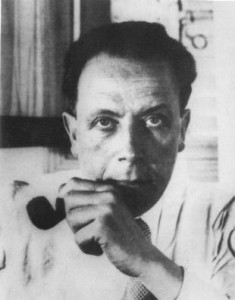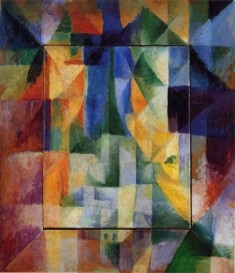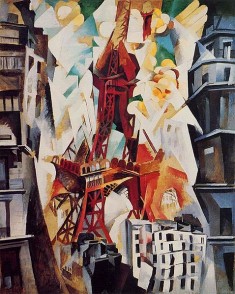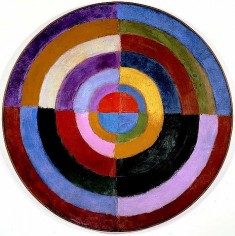| Robert Delaunay | |
|---|---|
 |
|
| Born | Apr. 12, 1885 Paris, France |
| Died | October 25, 1941 (at age 66) Montpellier, France |
| Nationality | French |
| Movement | Orphism, Cubism, Expressionism |
| Field | Painting |
| Works | |
French artist Robert Delaunay thought of colors as unique properties and phenomenon in the universe. His art focused on capturing the soul or essence of colors and their interplay with each other.
To this end, Delaunay co-founded a style known as Orphism, which is considered a branch of the more well-known Cubism. Orphism was different from Cubism in that is was even more abstract and rarely featured recognizable figures in favor of pure shape and color.
Delaunay’s Early Years and Development
Robert Delaunay was born in Paris in 1885, but his parents divorced while he was young. He was given over to be raised by his uncle and aunt, Charles and Marie Damour. As a marginal student, he essentially flunked out of what was then the equivalent of high school. He knew he wanted to be an artist, however, and displayed some talent.
Because of the talent that he showed, Delaunay’s stepparents agreed to send him to Ronsin’s atelier to study art. By 1902 at the age of 17, he was able to produce works worthy of public exhibition.
A turning point in Delaunay’s life came four years later in 1906 when he met Henri Rousseau and was also accepted into a collection of painters collectively known as the “group of Pont-Aven.” They worked in a communal art colony in Brittany where he met another influential friend and fellow artist, Jean Metzinger. Both Delaunay and Metzinger produced works with the Pont-Aven group which attracted the attention and praise of critics.
Delaunay’s Styles and Techniques
 At this early point in his career, Delaunay’s work was labeled as Neo-Impressionism. By 1908, he was moving into the purely abstract Orphism style that he may be best known for today. For the most part, he abandoned any figurative representations and concentrated on working with light and the optical characteristics of vibrant colors.
At this early point in his career, Delaunay’s work was labeled as Neo-Impressionism. By 1908, he was moving into the purely abstract Orphism style that he may be best known for today. For the most part, he abandoned any figurative representations and concentrated on working with light and the optical characteristics of vibrant colors.
1908 was also significant for Delaunay in that he met Sonia Terk, the wife of art dealer Wilhelm Uhde, a German man who was homosexual. Sonia had married him to help him hide his sexual orientation. It was at an art show sponsored by Udhe that Delaunay met Sonia, who quickly fell in love with him. She famously said of Delaunay: “… he is a poet not of words but of colors.”
Sonia soon divorced Uhde and married Delaunay. She was a Russian-born Jew who also possessed considerable artistic talent, and her inclinations and theory about art were similar to that of her new husband. The couple would be a tremendous influence on each other for the rest of their lives. They moved to Paris in 1910 where Robert entered into a new phase of his work.
Eiffel Tower Paintings
 In 1911, Robert Delaunay began to produce a series of paintings which helped him become well-known in the artistic world. These paintings were Cubist-like representations of the Eiffel Tower. Delaunay’s creations were influenced by Neo-Impressionism and the Futurist style as well as Cubism and a hint of Orphism.
In 1911, Robert Delaunay began to produce a series of paintings which helped him become well-known in the artistic world. These paintings were Cubist-like representations of the Eiffel Tower. Delaunay’s creations were influenced by Neo-Impressionism and the Futurist style as well as Cubism and a hint of Orphism.
Life in Spain
Robert and Sonia moved to Spain in 1914. When World War I broke out, Delaunay declined to return to France to join the military, for which he was labeled a “deserter.” It would later be shown he had good reason to avoid the war, however, because his health was deteriorating.
After adopting the combination of styles that produced the Eiffel Tower series and similar works, he returned to creating pure abstraction and his beloved experimentation with color.
Delaunay returned to Paris in 1921, where he and his wife produced a steady output of abstract paintings. He helped design railway and air travel pavilions for the 1937 World Fair conducted in Paris that year. By 1941, Delaunay had contracted cancer which claimed his life later in that same year.
Robert Delaunay’s Legacy
 The influence or Robert Delaunay’s work in his time was significant, and his work remains popular and relevant today. At the height of his career, however, he was overshadowed by some of the giant figures of the art world, including Picasso, Matisse, and Barque. But Delaney was an influence on these great painters as well. He is credited, for example, with bringing more color to Cubism, which at the time, favored limited or muted, underplayed color schemes.
The influence or Robert Delaunay’s work in his time was significant, and his work remains popular and relevant today. At the height of his career, however, he was overshadowed by some of the giant figures of the art world, including Picasso, Matisse, and Barque. But Delaney was an influence on these great painters as well. He is credited, for example, with bringing more color to Cubism, which at the time, favored limited or muted, underplayed color schemes.
Robert Delaunay’s paintings can be found in private art galleries and museums in various countries throughout the world today.